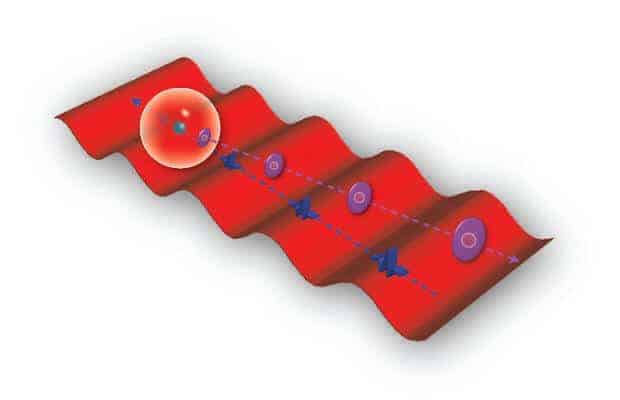Researchers have—for just a fraction of a second—glimpsed an electron’s-eye view of the world.
That is, they have succeeded for the first time in tracking an electron leaving the vicinity of an atom as the atom absorbs light. In a way akin to taking “snapshots” of the process, they were able to follow how each electron’s unique momentum changed over the incredibly short span of time it took to escape its host atom and become a free electron.
In the journal Nature Physics, the researchers write that following electrons in such fine detail constitutes a first step toward controlling electrons’ behavior inside matter—and thus the first step down a long and complicated road that could eventually lead to the ability to create new states of matter at will.
One immediate consequence is that researchers can now classify the quantum mechanical behavior of electrons from different atoms, explained project leader Louis DiMauro, Hagenlocker Chair and professor of physics at The Ohio State University.
“Now we can look at an electron and decipher its early history. We can ask how is it different if it came from a helium atom or a neon atom, for instance,” he said.
But the researchers’ ultimate goal is to map quantum mechanical systems—which apply to the ultra-small world—on a much larger scale so they can eventually direct the movements of sub-atomic particles inside a molecule.
“If you think of each snapshot we take as a frame in a movie, maybe someday we could stop the movie at one particular frame and change what happens next—say, by poking an electron with light and changing its direction. It would be like going inside a chemical reaction and making the reaction happen in a different way than it would naturally,” DiMauro said.
Essentially, he and physics doctoral student Dietrich Kiesewetter and their colleagues have proven that a well-established laboratory technique for studying free electrons could be used to study electrons that are not quite free yet, but rather in the process of exiting an atom.
Electrons behave differently when they can feel the tug of sub-atomic forces from a nucleus and neighbor electrons, and the farther away they get from an atom, those forces diminish. Though breaking free takes less than a femtosecond (one quadrillionth of a second), this study shows how an electron’s momentum changes many times along the way as it loses contact with individual parts of the atom. Those changes take place on the scale of attoseconds (thousandths of a femtosecond, or quintillionths of a second).
The technique the researchers used is called RABBITT, or Reconstruction of Attosecond Beating By Interfering Two-photon Transitions, and it involves hitting the atoms in a gas with light to reveal quantum mechanical information. It’s been around for nearly 15 years, and has become a standard procedure for studying processes that happen on very short timescales.
Not all the quantum mechanical information that comes from RABBITT is usable, however—or, at least, not all of it was thought to be usable until now. That’s why they’ve dubbed their version of the technique RABBITT+.
“We’re using the information that other people would throw away, the part that comes from close to the nucleus of the atom, because the data always seemed too complex to decipher,” DiMauro said. “We developed a model that shows we can extract some simple but important information from the more complex information.”
DiMauro credited Robert Jones, the Francis H. Smith Professor of Physics at the University of Virginia, with working out key elements of the model that made the information useful. Other co-authors of the paper include Pierre Agostini, professor of physics at Ohio State, and former doctoral students Stephen Schoun and Antoine Camper, who have since graduated.
This work was funded by the U.S. Department of Energy, Office of Science.
If our reporting has informed or inspired you, please consider making a donation. Every contribution, no matter the size, empowers us to continue delivering accurate, engaging, and trustworthy science and medical news. Independent journalism requires time, effort, and resources—your support ensures we can keep uncovering the stories that matter most to you.
Join us in making knowledge accessible and impactful. Thank you for standing with us!

